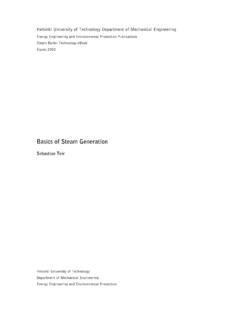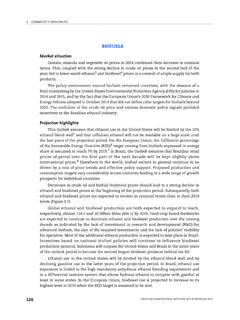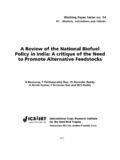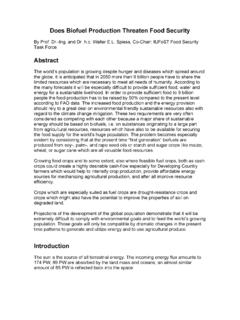Transcription of RELATION BETWEEN BIOFUELS VERSUS FOSSIL FUELS
1 PETROLEUM ENGINEERING DOWNSTREAM - RELATION BETWEEN BIOFUELS VERSUS FOSSIL FUELS - Lu s Cortez, Rog rio Cezar de Cerqueira Leite RELATION BETWEEN BIOFUELS VERSUS FOSSIL FUELS . Lu s Cortez Faculty of Agricultural Engineering FEAGRI, State University of Campinas . UNICAMP, Brazil Rog rio Cezar de Cerqueira Leite Interdisciplinary Center for Energy Planning NIPE, State University of Campinas . UNICAMP, Brazil Keywords: BIOFUELS , Ethanol, Biodiesel, Bioenergy, Biomass Contents S. TE S. 1. Introduction 2. Increase of the Greenhouse Effect and Atmospheric Temperature R.
2 AP LS. 3. History of the Technology and the Use of BIOFUELS 4. Possible Alternatives to Mitigate Carbon Dioxide Emissions 5. Photosynthesis and BIOFUELS C EO. 6. Productive Cycle of BIOFUELS 7. Production of Ethanol Production of Ethanol from Sugarcane Production of Ethanol from Corn E . 8. Second Generation of Ethanol: Hydrolysis and Fischer-Tropsch Technologies H. Hydrolysis Fischer Tropsch Process PL O. 9. Production of Biodiesel Raw Material M SC. Comparison of Biodiesel with Diesel Oil Process of Industrial Production of Biodiesel 10.
3 Bio-oil Production by Pyrolysis SA NE. 11. Points to Consider on BIOFUELS Production Sustainability Aspects Competition BETWEEN BIOFUELS and Food Production Producing BIOFUELS While Preserving Fragile Ecosystems U. Producing BIOFUELS While Creating Jobs 12. Final Considerations on the Production and Use of BIOFUELS 13. FOSSIL FUELS VERSUS BIOFUELS 14. Conclusion Related Chapters Glossary Bibliography Biographical Sketches Summary BIOFUELS are FUELS of bio origin, most frequently obtained from crops. The most important BIOFUELS are ethanol, obtained from sugarcane and corn, and biodiesel, Encyclopedia of Life Support Systems (EOLSS).
4 PETROLEUM ENGINEERING DOWNSTREAM - RELATION BETWEEN BIOFUELS VERSUS FOSSIL FUELS - Lu s Cortez, Rog rio Cezar de Cerqueira Leite obtained from oil seeds such as soybean, rapeseed and palm. As the world demand for FOSSIL FUELS increased substantially in the last decades, combined with the fact that FOSSIL FUELS are considered more expensive and claimed to be the main factor responsible for global warming, BIOFUELS are considered as an alternative. This chapter presents in some detail the production processes for the 1st generation of BIOFUELS , ethanol from sugarcane and corn, and biodiesel from oil crops.
5 Some alternative technologies for 2nd generation BIOFUELS are also presented, which will allow the use of the entire plant, such as the fibers, rendering it possible to obtain a more sustainable production of BIOFUELS with a considerably smaller impact on the environment. In addition, some considerations regarding BIOFUELS and some aspects comparing them with FOSSIL FUELS are also presented. Finally, the authors present the most important research challenges regarding BIOFUELS production and use, and the potential they have to become at least part of the world effort to reduce GHG emissions and global warming.
6 S. TE S. 1. Introduction R. AP LS. The so-called BIOFUELS are, in fact, FUELS of "bio" origin derived from plants, animals and microorganisms. In a certain way, the FOSSIL FUELS also fit into this given definition with the difference that, according to geologists, they are derived from the C EO. decomposition of organic matter for several million years. However, what is defined as biofuel today is more specifically the derivatives of plants or animals that are considered renewable, that is, which can continuously be produced.
7 In the definition of biofuel, materials such as firewood, methane gas, agricultural E . residues, vegetable or animal oils are included, as well as modern BIOFUELS , such as H. ethanol and biodiesel. Still today, in many countries of low economic and social PL O. development, firewood and other BIOFUELS such as biogas and even animal dung are intensely used as the base for their energy matrix. However, nowadays, the term M SC. BIOFUELS in general is related to liquid BIOFUELS , more specifically to ethanol.
8 Ethanol, also known as ethyl alcohol, is a colorless flammable liquid, also found in alcoholic beverages. Its chemical formula is C2H6O, the same as dimethyl ether. Biodiesel is a SA NE. biofuel obtained from oils and fats of animal or vegetable origin, with an alcohol, either methanol or ethanol, in the presence of a catalyst, in a reaction known as transesterification. It can also be obtained by cracking or esterification processes. U. Countries such as Brazil, the , Germany and France, throughout decades, have constructed an industry directed to the production and use of significant amounts of ethanol and biodiesel, incorporating them into their energy matrices.
9 However, as will be discussed, when BIOFUELS are considered and used on a global scale, the main objective is the possibility of reducing FOSSIL -fuel utilization and reducing its correspondent greenhouse gas emissions (GHG). Therefore, the amount of renewable energy that can be produced by unit of FOSSIL -fuel energy utilized in the entire biofuel production process becomes critical. This rate is called life cycle . 2. Increase of the Greenhouse Effect and Atmospheric Temperature What makes the world today consider the production and use of BIOFUELS on a wide scale is the high level of atmospheric pollution caused by the intensive use of FOSSIL FUELS .
10 Encyclopedia of Life Support Systems (EOLSS). PETROLEUM ENGINEERING DOWNSTREAM - RELATION BETWEEN BIOFUELS VERSUS FOSSIL FUELS - Lu s Cortez, Rog rio Cezar de Cerqueira Leite Since the industrial revolution in the XIX century, humanity and, more specifically, the developed countries, have based their development model on non-renewable sources of energy such as petroleum, natural gas and coal. The use of these FOSSIL -fuel sources emits gases such as carbon dioxide (CO2), methane (CH4) and other hydrocarbons, increasing the so-called greenhouse effect and, consequently, provoking an increase in the atmospheric temperature of our planet (Figures 1 and 2).















